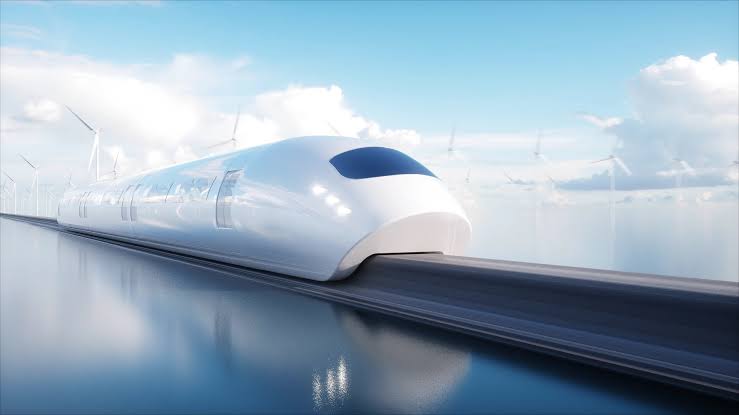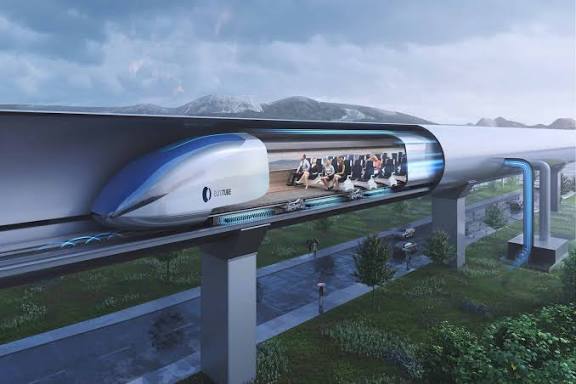
Future of Transportation: From Electric Cars to Flying Taxis
The future of transportation is accelerating toward cleaner, smarter, and more innovative solutions. Electric vehicles, autonomous cars, flying taxis, and Hyperloop systems promise to revolutionize how we move. These advancements aim to reduce environmental impact, increase efficiency, and ease congestion in urban areas. Technologies like Mobility-as-a-Service (MaaS) and smart city traffic systems are making travel more seamless. With growing interest in drones and sustainable fuels, both ground
✨ Raghav Jain

Introduction
Transportation has always been a reflection of human progress—from horse-drawn carts to steam engines, from gasoline-powered vehicles to high-speed trains. Today, we stand at the threshold of the next major revolution in mobility. Driven by the urgent need for sustainability, rapid urbanization, and advancements in technology, the future of transportation promises to be cleaner, faster, smarter, and more personalized than ever before.
Electric vehicles (EVs), autonomous driving, hyperloops, and flying taxis are no longer science fiction—they’re fast becoming reality. With each passing year, innovations in transportation are reshaping how people and goods move across cities, countries, and even continents.
This article explores the cutting-edge trends and emerging technologies that are set to define the future of transportation, transforming our daily commutes and global logistics systems in ways we've only begun to imagine. The landscape of transportation is on the cusp of a profound transformation in 2025. Driven by pressing environmental concerns, rapid technological advancements, and the ever-increasing demand for efficient and convenient mobility, the future of how we move people and goods is becoming increasingly dynamic and diverse. While electric cars are solidifying their position as a mainstream alternative to traditional combustion engine vehicles, a plethora of other innovative transportation solutions, ranging from autonomous vehicles to high-speed underground networks and even personal aerial vehicles, are rapidly developing and promising to reshape our commutes, our cities, and our connection to the world. This exploration delves into the exciting future of transportation, examining the key innovations poised to revolutionize how we travel, from the widespread adoption of electric cars to the nascent yet promising realm of flying taxis and beyond.
The Electric Revolution Accelerates
The transition to electric vehicles (EVs) is no longer a distant aspiration but a tangible reality in 2025. Years of advancements in battery technology, charging infrastructure, and government incentives have propelled EVs into the mainstream. The future of personal transportation is undeniably electric, with projections indicating a significant majority of new car sales will be electric by the next decade. Several key factors are driving this revolution. Firstly, battery technology continues to improve, offering longer ranges, faster charging times, and decreasing costs. Solid-state batteries, poised for wider adoption in the late 2020s, promise even greater energy density and enhanced safety. Secondly, the charging infrastructure is rapidly expanding, with more public charging stations, faster charging technologies (like ultra-fast DC charging), and innovative solutions like wireless charging becoming increasingly prevalent. Governments worldwide are also playing a crucial role through supportive policies and incentives, including tax credits, subsidies, and regulations phasing out the sale of new gasoline-powered vehicles.
Beyond passenger cars, the electric revolution is extending to other modes of transportation. Electric buses and trucks are becoming increasingly viable for public transit and freight transport, contributing to cleaner urban environments and reduced emissions. Electric two-wheelers and scooters are also gaining popularity, particularly in urban areas, offering a sustainable and agile mode of personal mobility. The development of electric aircraft and ships, while still in earlier stages, holds immense potential for decarbonizing air and maritime travel in the long term.
The Dawn of Autonomous Mobility
Autonomous vehicles (AVs), once confined to the realm of science fiction, are steadily progressing towards real-world deployment in 2025. While fully autonomous vehicles for unrestricted public roads are still under development and facing regulatory hurdles, significant advancements are being made in driver-assistance systems (ADAS), offering increasing levels of automation in tasks like lane keeping, adaptive cruise control, and automated parking. These technologies are not only enhancing driver safety and convenience but also paving the way for the eventual widespread adoption of fully autonomous vehicles.
The future of transportation envisions a world where robotaxis and autonomous shuttles provide on-demand mobility services, particularly in urban environments. These shared autonomous fleets have the potential to alleviate traffic congestion, reduce the need for personal car ownership, and make transportation more accessible for the elderly and those with disabilities. Autonomous trucks promise to revolutionize freight transport, potentially leading to increased efficiency, reduced costs, and improved safety on highways. However, the widespread deployment of autonomous vehicles necessitates addressing crucial challenges related to safety, regulation, cybersecurity, and public acceptance.
Taking to the Skies: The Promise of Flying Taxis
Perhaps one of the most exciting and transformative innovations on the horizon is the emergence of electric vertical takeoff and landing (eVTOL) aircraft, often referred to as flying taxis. These compact, electric-powered aircraft offer the potential for on-demand aerial mobility, bypassing ground-based traffic congestion and significantly reducing travel times in urban areas. In 2025, several companies are actively developing and testing eVTOL prototypes, with the first commercial deployments anticipated in the coming years.
The benefits of flying taxis are numerous. They offer a faster and more direct mode of transportation in congested cities, connecting key locations like airports, business districts, and residential areas with unprecedented speed. Their electric propulsion systems contribute to quieter and cleaner urban environments compared to traditional helicopters. Furthermore, the development of vertiports – dedicated takeoff and landing infrastructure – is progressing, with plans for integration into existing urban landscapes, such as rooftops and parking garages. However, challenges related to safety regulations, air traffic management, noise pollution, and public acceptance need to be addressed before flying taxis become a ubiquitous mode of urban transport.
Beyond Roads and Skies: Exploring Other Innovations
While electric cars and flying taxis are garnering significant attention, the future of transportation encompasses a broader range of innovative solutions. High-speed rail networks continue to expand globally, offering a sustainable and efficient alternative to air travel for medium-distance journeys. Hyperloop technology, which envisions passenger pods traveling at extremely high speeds through vacuum tubes, is still in the development and testing phase but holds the potential to revolutionize long-distance travel.
Micromobility solutions, such as electric scooters and bikes, are becoming increasingly integrated into urban transportation networks, providing flexible and eco-friendly options for short-distance travel. Drone technology is also evolving beyond recreational use, with potential applications in last-mile delivery, cargo transport, and infrastructure inspection. Furthermore, advancements in smart infrastructure and connected vehicles promise to optimize traffic flow, enhance safety, and improve the overall efficiency of transportation systems.
A Connected and Sustainable Future
The future of transportation in 2025 and beyond is characterized by a convergence of electrification, automation, and connectivity. These trends are driven by a shared vision of creating a more sustainable, efficient, and accessible transportation system for all. While challenges remain in terms of technological development, regulatory frameworks, and infrastructure deployment, the momentum behind these innovations is undeniable. From the quiet hum of electric cars on our streets to the futuristic vision of flying taxis soaring above our cities, the way we move is on the cusp of a transformative era, promising to reshape our lives and our world in profound ways. The journey ahead will be dynamic and complex, but the destination – a more connected and sustainable future of transportation – is within sight.
1. The Electric Vehicle (EV) Revolution
Electric cars are leading the way in redefining transportation. With concerns over climate change, carbon emissions, and rising fuel prices, electric vehicles have become the most promising alternative to internal combustion engines.
Key Drivers of the EV Boom:
- Government policies: Subsidies, tax breaks, and emission regulations are accelerating EV adoption worldwide.
- Technological advancements: Better battery technology, increased range, and faster charging are reducing "range anxiety."
- Consumer awareness: People are becoming more environmentally conscious and prefer eco-friendly transport options.
Notable Players:
- Tesla continues to dominate with its innovation and supercharging network.
- Traditional automakers like Ford, General Motors, and Volkswagen are heavily investing in EVs.
- Indian companies like Tata Motors and Ola Electric are also playing a pivotal role in making EVs accessible.
By 2040, it's estimated that over 50% of all new cars sold will be electric, leading to cleaner cities and quieter roads.
2. Charging Infrastructure and Battery Innovation
One of the main barriers to widespread EV adoption has been the charging infrastructure. However, this is rapidly changing.
Emerging Trends:
- Ultra-fast charging stations are being installed across highways, cutting charging time to under 15 minutes.
- Wireless charging or inductive charging allows EVs to recharge without physical cables—especially useful for buses and taxis.
- Battery swapping is gaining traction, particularly in countries like India and China, allowing instant refueling.
Battery Tech Innovations:
- Solid-state batteries: Safer, lighter, and more energy-dense than lithium-ion batteries.
- Recyclable and sustainable materials: To reduce the environmental impact of battery production.
These advancements will ensure EVs become more affordable, accessible, and efficient in the years to come.
3. Autonomous Vehicles: The Era of Self-Driving Cars
Autonomous or self-driving vehicles use a combination of AI, machine learning, lidar, radar, and cameras to navigate without human input. While fully autonomous vehicles are still being tested, the future they promise is revolutionary.
Potential Benefits:
- Fewer accidents: Over 90% of traffic accidents are due to human error.
- Increased efficiency: Optimized driving reduces congestion and fuel consumption.
- Accessibility: Self-driving cars can help the elderly and disabled move independently.
Current Progress:
- Waymo, a subsidiary of Alphabet, operates a self-driving taxi service in Phoenix, USA.
- Tesla's Full Self-Driving (FSD) is in beta and gradually improving.
- Many logistics companies are experimenting with autonomous delivery trucks and drones.
While regulatory challenges remain, experts believe Level 5 autonomy (fully self-driving in all conditions) will become mainstream within the next decade.
4. Flying Taxis and Urban Air Mobility (UAM)
Imagine avoiding city traffic by simply flying over it. Flying taxis, also known as electric vertical take-off and landing vehicles (eVTOLs), are no longer the stuff of dreams. Urban air mobility aims to introduce on-demand aerial transport within cities.
Companies Leading the Charge:
- Joby Aviation, Lilium, and Volocopter are already conducting test flights.
- Uber Elevate (now part of Joby) had planned air taxi launches in major cities.
- Hyundai and Airbus are working on commercial flying car concepts.
Use Cases:
- Airport-to-city transfers
- Emergency medical transport
- Traffic relief in megacities
While safety, air traffic control, and public acceptance are key concerns, pilotless flying taxis could be common in metropolitan skies by the 2030s.
5. Hyperloop: The Future of High-Speed Ground Travel
First envisioned by Elon Musk, hyperloop is a high-speed transportation system where pods travel through low-pressure tubes at speeds up to 1,000 km/h (620 mph).
How It Works:
- Magnetic levitation (maglev) lifts and propels pods.
- Near-vacuum environments reduce friction and air resistance.
- Energy-efficient and faster than high-speed rail.
Key Projects:
- Virgin Hyperloop has successfully tested passenger pods.
- India's Mumbai-Pune Hyperloop is under review.
- Dubai and Saudi Arabia are exploring hyperloop for smart city transport.
If implemented, hyperloop could drastically cut travel time between major cities and transform intercity mobility forever.
6. Sustainable Mobility and Microtransport
The future of transportation is not just about speed—sustainability is a top priority. This includes promoting public transit, cycling, e-scooters, and pedestrian-friendly infrastructure.
Microtransport Solutions:
- Electric scooters and e-bikes for last-mile connectivity.
- Shared mobility platforms like Yulu, Bounce, and Lime.
- Bike highways and green lanes to encourage eco-commuting.
Cities around the world are integrating these into their smart transportation ecosystems, reducing dependence on cars and cutting down emissions.
7. Smart Cities and Connected Transportation
In a smart city, transportation will be interconnected, data-driven, and seamlessly integrated with infrastructure and technology.
Features of Smart Mobility:
- IoT-enabled traffic lights that respond to congestion in real-time.
- AI-powered traffic prediction and route optimization.
- Smart parking systems that reduce time spent searching for spots.
- Integrated transport apps that combine buses, metros, cabs, and rentals into one system.
The goal is to make transportation efficient, cost-effective, and less polluting—all while enhancing the commuter experience.
8. Greener Public Transport
Modern cities are now replacing diesel and petrol-run buses with electric and hydrogen-powered buses to reduce pollution.
Examples:
- London and Delhi are expanding their electric bus fleets.
- Hydrogen buses are being tested in Japan, Germany, and South Korea.
- Solar-powered trains are being explored in Australia and parts of India.
This shift is crucial for mass decarbonization of public transportation systems, especially in highly populated urban areas.
9. AI and Big Data in Transportation
Artificial Intelligence (AI) and Big Data are playing a crucial role in optimizing transport systems.
Applications:
- Predictive maintenance of vehicles and infrastructure
- Real-time traffic management using data analytics
- Dynamic pricing and route management for public transport
- Fleet optimization for logistics companies
By harnessing the power of AI, transportation networks can become smarter, safer, and more adaptive to demand patterns and emergencies.
10. Drones and Automated Delivery Systems
Drones are not only being used for aerial photography but also for delivering packages, medical supplies, and even food.
Major Developments:
- Amazon Prime Air and Zipline are testing drone delivery systems.
- Swiggy and Zomato in India have started drone food delivery trials.
- Drones can access remote areas during disasters or pandemics.
In the future, drones and small autonomous bots could become essential for fast, contactless deliveries in both urban and rural settings.
Conclusion
The future of transportation is not about one big innovation—but rather, a convergence of multiple transformative technologies. From electric cars and AI-driven systems to flying taxis and hyperloop travel, we are entering a new era where mobility is clean, fast, intelligent, and interconnected.
These advancements will not only change how we commute but will also influence urban planning, environmental policy, economic development, and even how we interact with one another.
While challenges remain—such as infrastructure, cost, regulations, and public adaptation—the momentum is unstoppable. Governments, private companies, and communities must work together to build a sustainable, inclusive, and high-tech transportation future.
As we look ahead, one thing is certain: the journey itself is about to become just as exciting as the destination.
Q&A Section
Q1: What is the future of transportation focused on?
Ans: The future of transportation focuses on sustainability, efficiency, and innovation by integrating electric vehicles, autonomous systems, and air mobility into daily life.
Q2: How are electric cars changing the transportation landscape?
Ans: Electric cars reduce carbon emissions, lower fuel costs, and provide a cleaner alternative to traditional gasoline-powered vehicles, contributing to a greener future.
Q3: What are autonomous vehicles and how do they work?
Ans: Autonomous vehicles, or self-driving cars, use sensors, AI, and machine learning to navigate and drive without human input, aiming to reduce accidents and traffic.
Q4: What is Hyperloop technology and how fast can it travel?
Ans: Hyperloop is a high-speed transportation system that uses vacuum tubes and magnetic levitation to move pods at speeds up to 700 mph, revolutionizing long-distance travel.
Q5: What role do drones play in future transportation?
Ans: Drones are being developed for deliveries, emergency response, and even passenger transport, offering fast and efficient movement, especially in congested areas.
Q6: What are flying taxis and how soon can we expect them?
Ans: Flying taxis are electric vertical take-off and landing (eVTOL) aircraft designed for urban air mobility. Trials are underway, and commercial use is expected within the next decade.
Q7: How does smart transportation benefit urban cities?
Ans: Smart transportation systems use real-time data and connectivity to manage traffic, reduce congestion, and enhance safety and commuting efficiency in cities.
Q8: What is Mobility-as-a-Service (MaaS) and how does it work?
Ans: MaaS integrates various transport services—like ride-sharing, buses, trains—into a single digital platform, allowing users to plan, book, and pay for trips seamlessly.
Q9: How are sustainable fuels influencing future transport systems?
Ans: Sustainable fuels such as biofuels and hydrogen are reducing carbon footprints in aviation, shipping, and public transport, supporting eco-friendly mobility.
Q10: What challenges does the future of transportation face?
Ans: Key challenges include infrastructure development, regulatory policies, safety concerns, and public acceptance of new technologies like autonomous and airborne vehicles.
Similar Articles
Find more relatable content in similar Articles

How Wearable Devices Detect Hu..
Wearable devices use biosenso.. Read More

The Role of AI Facial Recognit..
AI facial recognition is revo.. Read More

Latest Dermatology Devices En..
The latest dermatology device.. Read More

Hyperloop Technology: A Game-..
Hyperloop technology envision.. Read More
Explore Other Categories
Explore many different categories of articles ranging from Gadgets to Security
Smart Devices, Gear & Innovations
Discover in-depth reviews, hands-on experiences, and expert insights on the newest gadgets—from smartphones to smartwatches, headphones, wearables, and everything in between. Stay ahead with the latest in tech gear
Apps That Power Your World
Explore essential mobile and desktop applications across all platforms. From productivity boosters to creative tools, we cover updates, recommendations, and how-tos to make your digital life easier and more efficient.
Tomorrow's Technology, Today's Insights
Dive into the world of emerging technologies, AI breakthroughs, space tech, robotics, and innovations shaping the future. Stay informed on what's next in the evolution of science and technology.
Protecting You in a Digital Age
Learn how to secure your data, protect your privacy, and understand the latest in online threats. We break down complex cybersecurity topics into practical advice for everyday users and professionals alike.
© 2025 Copyrights by rTechnology. All Rights Reserved.